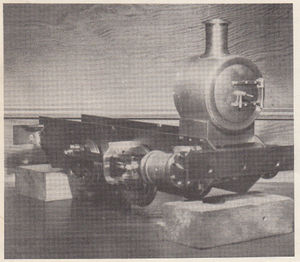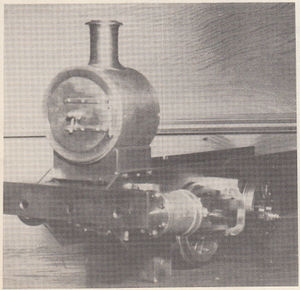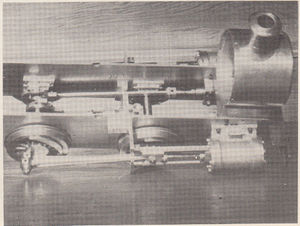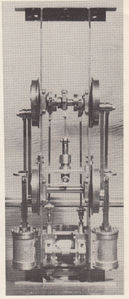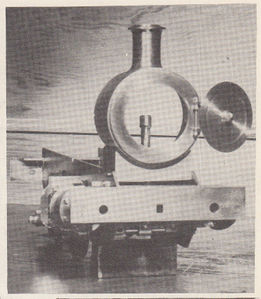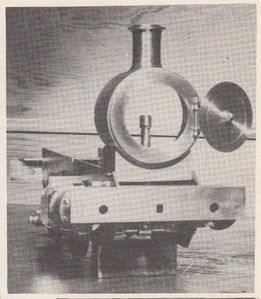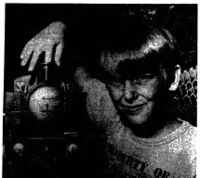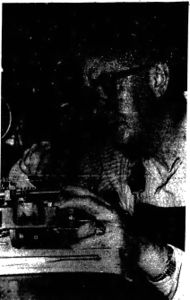Al Barkdull
- Al W. Barkdull
- 33 N. Gamble St
- Shelby, Ohio
Photos of Al Barkdull's 0-4- while under construction. The chassis is identical with the English "Juliet".
Valve gear is fool-proof loose eccentric, a great time saver and valve events are the same at both ends, forward and reverse. The boiler is of copper 3-1/2 inch in diameter, 3 inch diameter wheels and the cylinders are 1 inch bore. She has inside steam chests making her a simple job for a first attempt.
With loose eccentrics a short movement of the loco in either direction quickly picks up the main eccentric and its ready to roll.
Al Barkdull with his version of "Juliet". Cover of The North American Live Steamer, Volume 1 Number 6.
Backyard Train Keeps Him Busy
Back Yard Train Keeps Him Busy
Shelby Man Relives Steam Era
by Ron Simon
Mannsfield Ohio News Journal
Sunday, August 3, 1969
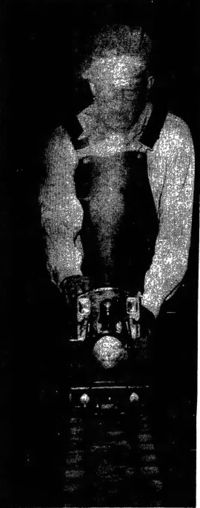
The age of steam locomotives on America's railroads is gone, but in his own backyard Al Barkdull of 114 Mansfield Ave., Shelby, Ohio, has recreated the era in part with his own miniature steam engine and track.
A partner with his father Earl in the Barkdull Funeral Home, Al Barkdull has been fascinated by steam locomotives since he was five-years-old.
Not caring to settle for a model railroad on a table-top, he became a backyard railroad man by building his own steam engine back in 1953, just as the era of steam locomotives was coming to an end.
Barkdull's engine, modeled on an australian four-wheeled switching engine, stands about 10 inches high and weighs 35 pounds. It can pull four adults on miniature cars behind it, takes 80 pounds of steam pressure per square inch to operate, and has traveled more than 1,500 miles at live-steam meets and in Barkdull's back yard.
The engine, which has the name "Blackfork and Western" written on the side of its tender, usually travels on a track running 135 feet across Barkdull's yard. The track is elevated two feet off the ground and climbs a slight grade.
It took Barkdull about one year to build the engine and one month to construct the track.
The little engine is powered by a hard coal specially imported from Wales. Nearly pure carbon in content, the miniature lumps are kerosene soaked and fed into the engine's tiny firebox with a teaspoon.
"You can scale locomotives down, but you can't scale down nature," Barkdull explained, pointing out that his engine is run on the same principals as its giant big brothers of earlier times.
Along the side of the engine are two water tanks which feed water into the boiler. Its power is roughly equal for its size to that of the real engine it was modeled after.
"It has amazing pulling power," Barkdull said. "It has puled away from a standing position while four adults sat on two riding cars attached to it." He has never measured its speed, although it did get away from him during a live-steam meet. "I couldn't catch it," he recalled.
Barkdull belongs to the International Brotherhood of Live Steamers. This group holds meets throughout North America. Barkdull has attended meets in Toronto, Canada; Detroit; Southwick, Mass.; Cedar Rapids, Iowa; and Lafayette, Ind. Meets for local groups have been held in the Ohio towns of Continental, Dephos, Mentor, Bryan, and the cities of Lorain and Cincinnati.
"I really look forward to those meets because the fellowship at them is great," Barkdull said.
He explained that no dues are paid except to keep up special club trackage and that there is no competition at meets. "We just get together for the pleasure of watching out locomotives work."
The only other live-steam fan in the area that Barkdull knows of is his neighbor, Ross McKinney, who is building a six-wheel switch engine.
Barkdull is building a second engine, modeled on a six-wheel Baltimore and Ohio switch engine, in his basement workshop. He has been working on this engine for the past 12 years.
He explained that almost all live-steam engines are built in home workshops. Although there are some custom builders in the U.S. and England, Barkdull said most live-steam fans prefer the challenge of building their own products. There are, he adds, about 2,500 live-steam fans in the U.S.
As for the original steam engine, he called their demise "heartbreaking." The last steam engine in the area was a Mikado engine used as a switcher on the B & O railroad in Shelby, and Barkdull spent much thime in the late 1950s watching it work.
"I hated to see that engine go," he added.
Hobbyist at work - Al Barkdull of Shelby, OH, works on the chassis of his second engine, a six-wheeled B&O switcher, in his basement workshop. He has been working on this engine off and on for 12 years.
